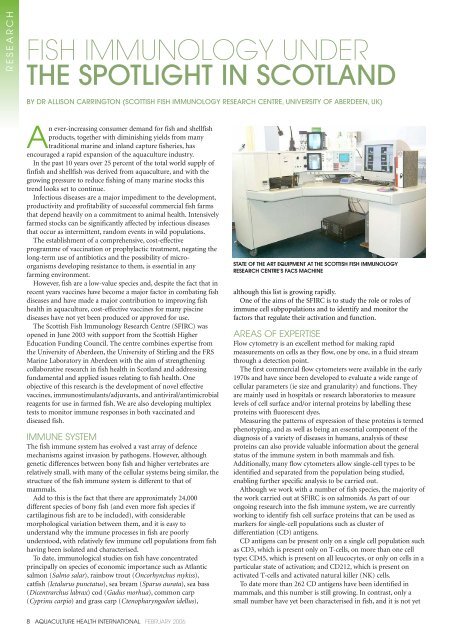aquaculturehealth - Montana Water Center - Montana State University
aquaculturehealth - Montana Water Center - Montana State University
aquaculturehealth - Montana Water Center - Montana State University
You also want an ePaper? Increase the reach of your titles
YUMPU automatically turns print PDFs into web optimized ePapers that Google loves.
RESEARCH<br />
FISH IMMUNOLOGY UNDER<br />
THE SPOTLIGHT IN SCOTLAND<br />
BY DR ALLISON CARRINGTON (SCOTTISH FISH IMMUNOLOGY RESEARCH CENTRE, UNIVERSITY OF ABERDEEN, UK)<br />
An ever-increasing consumer demand for fish and shellfish<br />
products, together with diminishing yields from many<br />
traditional marine and inland capture fisheries, has<br />
encouraged a rapid expansion of the aquaculture industry.<br />
In the past 10 years over 25 percent of the total world supply of<br />
finfish and shellfish was derived from aquaculture, and with the<br />
growing pressure to reduce fishing of many marine stocks this<br />
trend looks set to continue.<br />
Infectious diseases are a major impediment to the development,<br />
productivity and profitability of successful commercial fish farms<br />
that depend heavily on a commitment to animal health. Intensively<br />
farmed stocks can be significantly affected by infectious diseases<br />
that occur as intermittent, random events in wild populations.<br />
The establishment of a comprehensive, cost-effective<br />
programme of vaccination or prophylactic treatment, negating the<br />
long-term use of antibiotics and the possibility of microorganisms<br />
developing resistance to them, is essential in any<br />
farming environment.<br />
However, fish are a low-value species and, despite the fact that in<br />
recent years vaccines have become a major factor in combating fish<br />
diseases and have made a major contribution to improving fish<br />
health in aquaculture, cost-effective vaccines for many piscine<br />
diseases have not yet been produced or approved for use.<br />
The Scottish Fish Immunology Research Centre (SFIRC) was<br />
opened in June 2003 with support from the Scottish Higher<br />
Education Funding Council. The centre combines expertise from<br />
the <strong>University</strong> of Aberdeen, the <strong>University</strong> of Stirling and the FRS<br />
Marine Laboratory in Aberdeen with the aim of strengthening<br />
collaborative research in fish health in Scotland and addressing<br />
fundamental and applied issues relating to fish health. One<br />
objective of this research is the development of novel effective<br />
vaccines, immunostimulants/adjuvants, and antiviral/antimicrobial<br />
reagents for use in farmed fish. We are also developing multiplex<br />
tests to monitor immune responses in both vaccinated and<br />
diseased fish.<br />
IMMUNE SYSTEM<br />
The fish immune system has evolved a vast array of defence<br />
mechanisms against invasion by pathogens. However, although<br />
genetic differences between bony fish and higher vertebrates are<br />
relatively small, with many of the cellular systems being similar, the<br />
structure of the fish immune system is different to that of<br />
mammals.<br />
Add to this is the fact that there are approximately 24,000<br />
different species of bony fish (and even more fish species if<br />
cartilaginous fish are to be included), with considerable<br />
morphological variation between them, and it is easy to<br />
understand why the immune processes in fish are poorly<br />
understood, with relatively few immune cell populations from fish<br />
having been isolated and characterised.<br />
To date, immunological studies on fish have concentrated<br />
principally on species of economic importance such as Atlantic<br />
salmon (Salmo salar), rainbow trout (Oncorhynchus mykiss),<br />
catfish (Ictalurus punctatus), sea bream (Sparus aurata), sea bass<br />
(Dicentrarchus labrax) cod (Gadus morhua), common carp<br />
(Cyprinu carpio) and grass carp (Ctenopharyngodon idellus),<br />
STATE OF THE ART EQUIPMENT AT THE SCOTTISH FISH IMMUNOLOGY<br />
RESEARCH CENTRE’S FACS MACHINE<br />
although this list is growing rapidly.<br />
One of the aims of the SFIRC is to study the role or roles of<br />
immune cell subpopulations and to identify and monitor the<br />
factors that regulate their activation and function.<br />
AREAS OF EXPERTISE<br />
Flow cytometry is an excellent method for making rapid<br />
measurements on cells as they flow, one by one, in a fluid stream<br />
through a detection point.<br />
The first commercial flow cytometers were available in the early<br />
1970s and have since been developed to evaluate a wide range of<br />
cellular parameters (ie size and granularity) and functions. They<br />
are mainly used in hospitals or research laboratories to measure<br />
levels of cell surface and/or internal proteins by labelling these<br />
proteins with fluorescent dyes.<br />
Measuring the patterns of expression of these proteins is termed<br />
phenotyping, and as well as being an essential component of the<br />
diagnosis of a variety of diseases in humans, analysis of these<br />
proteins can also provide valuable information about the general<br />
status of the immune system in both mammals and fish.<br />
Additionally, many flow cytometers allow single-cell types to be<br />
identified and separated from the population being studied,<br />
enabling further specific analysis to be carried out.<br />
Although we work with a number of fish species, the majority of<br />
the work carried out at SFIRC is on salmonids. As part of our<br />
ongoing research into the fish immune system, we are currently<br />
working to identify fish cell surface proteins that can be used as<br />
markers for single-cell populations such as cluster of<br />
differentiation (CD) antigens.<br />
CD antigens can be present only on a single cell population such<br />
as CD3, which is present only on T-cells, on more than one cell<br />
type; CD45, which is present on all leucocytes, or only on cells in a<br />
particular state of activation; and CD212, which is present on<br />
activated T-cells and activated natural killer (NK) cells.<br />
To date more than 262 CD antigens have been identified in<br />
mammals, and this number is still growing. In contrast, only a<br />
small number have yet been characterised in fish, and it is not yet<br />
8 AQUACULTURE HEALTH INTERNATIONAL FEBRUARY 2006






